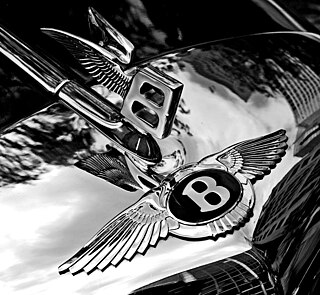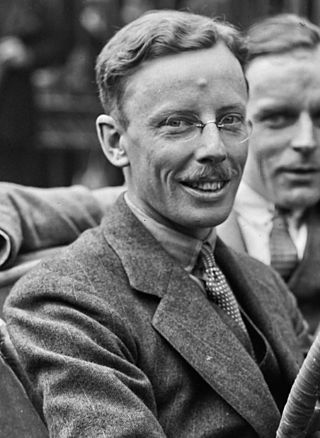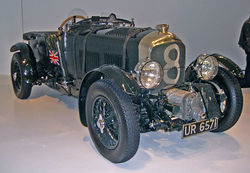
Bentley Motors Limited is a British designer, manufacturer and marketer of luxury cars and SUVs. Headquartered in Crewe, England, the company was founded by W. O. Bentley (1888–1971) in 1919 in Cricklewood, North London, and became widely known for winning the 24 Hours of Le Mans in 1924, 1927, 1928, 1929 and 1930. Bentley has been a subsidiary of the Volkswagen Group since 1998 and consolidated under VW's premium brand arm Audi since 2022.

Walter Owen Bentley, was an English engineer who founded Bentley Motors Limited in London. He was a motorcycle and car racer as a young man. After making a name for himself as a designer of aircraft and automobile engines, Bentley established his own firm in 1919. He built the firm into one of the world's premier luxury and performance auto manufacturers, and led the marque to multiple victories at the 24 Hours of Le Mans. After selling his namesake company to Rolls-Royce Limited in 1931, he was employed as a designer for Lagonda, Aston Martin, and Armstrong Siddeley.

Sir Henry Ralph Stanley Birkin, 3rd Baronet, known as Tim Birkin, was a British racing driver, one of the "Bentley Boys" of the 1920s.

The Bentley 4½ Litre is a British car based on a rolling chassis built by Bentley Motors. Walter Owen Bentley replaced the Bentley 3 Litre with a more powerful car by increasing its engine displacement to 4.4 litres. A racing variant was known as the Blower Bentley.

The Bentley 6½ Litre and the high-performance Bentley Speed Six were rolling chassis in production from 1926 to 1930. The Speed Six, introduced in 1928, became the most successful racing Bentley. Two Bentley Speed Sixes became known as the Blue Train Bentleys after their owner Woolf Barnato raced the Blue Train in 1930.

The Bentley 3½ Litre was presented to the public in September 1933, shortly after the death of Henry Royce, and was the first new Bentley model following Rolls-Royce's acquisition of the Bentley brand in 1931.

Joel Woolf Barnato was a British financier and racing driver, one of the "Bentley Boys" of the 1920s. He achieved three consecutive wins out of three entries in the 24 Hours of Le Mans race.
The 1930 24 Hours of Le Mans was the 8th Grand Prix of Endurance that took place at the Circuit de la Sarthe on 21 and 22 June 1930. It saw the first appearance of a German car and the first entry from female drivers.

The 1929 24 Hours of Le Mans was the 7th Grand Prix of Endurance that took place at the Circuit de la Sarthe on 15 and 16 June 1929.
The 1928 24 Hours of Le Mans was the 6th Grand Prix of Endurance that took place at the Circuit de la Sarthe on 16 and 17 June 1928.
The 1926 24 Hours of Le Mans was the 4th Grand Prix of Endurance, and took place on 12 and 13 June 1926. It was the first Le Mans race where the winner's average speed was over 100 km/h (62 mph), and also the first to break the 24-hour distance record set by Selwyn Edge at Brooklands in 1907.

John Francis Duff was a Canadian racing driver. He is best known for winning the 1924 24 Hours of Le Mans.
Beresford Clive Dunfee was a British racing driver, one of the "Bentley Boys" of the 1930s, who was killed in a dramatic accident at Brooklands.

Bernard Rubin was an Australian racing driver and pilot who was a member of the "Bentley Boys" team at the Bentley Motor Company and winner of the 1928 24 Hours of Le Mans.
The Blue Train Races were a series of record-breaking attempts between automobiles and trains in the late 1920s and early 1930s. It saw a number of motorists and their own or sponsored automobiles race against the Le Train Bleu, a train that ran between Calais and the French Riviera. The rationale to beat the train was to compare the contemporary automotive performance with locomotive dominance; to showcase recent progress achieved by cars regarding reliability, durability, speed and comfort; to promote the cars, their marques and the adventurous persona of their drivers; and to establish automobiles as a viable and aspirational mode of transport for the individual traveller.
Dudley Noble, who started at the Rover Company in 1911 as a motorcycle tester and competition rider, became one of the British automobile industry's pioneering publicists.

Bentley Blower No.1 is a racing car developed from the Bentley 4½ Litre by Sir Henry "Tim" Birkin to win the Le Mans twenty-four-hour race. The car was developed into its current form for racing at Brooklands.

Colonel Reginald Clive Gallop was an engineer, racing driver and First World War pilot. He was one of the team which developed their first engine for Bentley Motors.
Jack Lawson Dunfee was a British motor racing driver, theatrical impresario, and later farmer who was one of the "Bentley Boys" at Brooklands before the Second World War.

Margaret Mabel Gladys Jennings was a Scottish motor racing driver. As Margaret Allan she was one of the leading British female racing and rally drivers in the inter-war years, and one of only four women ever to earn a 120 mph badge at the Brooklands circuit. During the war, Jennings worked as an ambulance driver and then at Bletchley Park's intelligence de-coding centre, and afterwards became a journalist and was Vogue magazine's motoring correspondent from 1948 to 1957.













